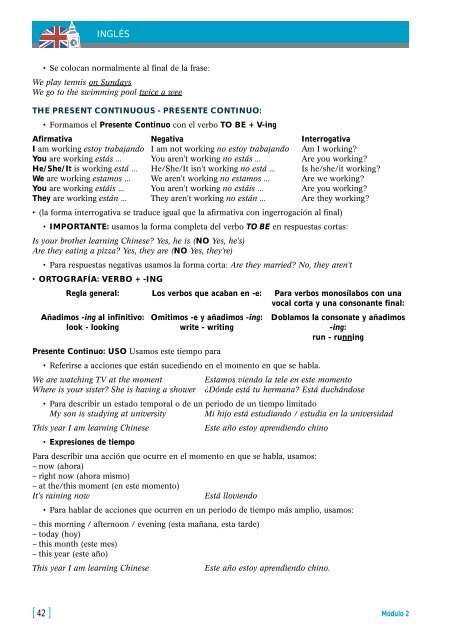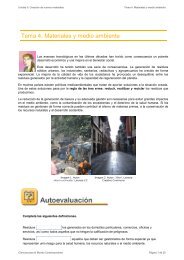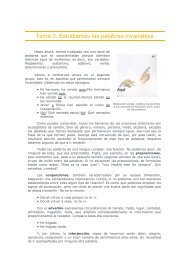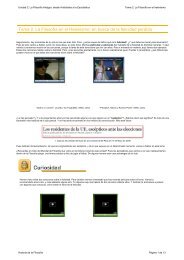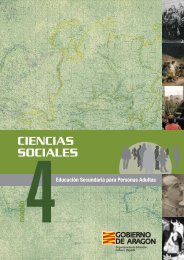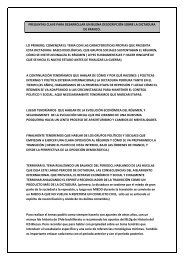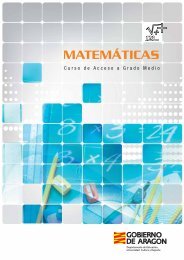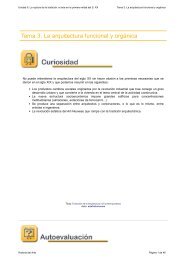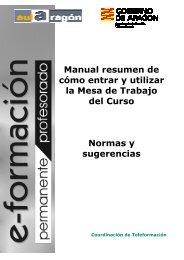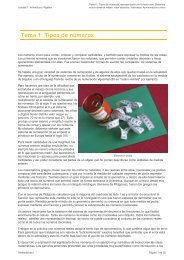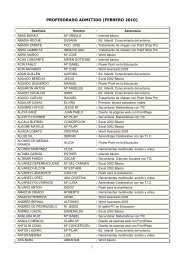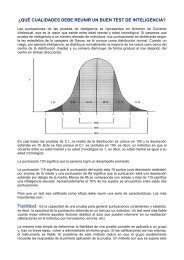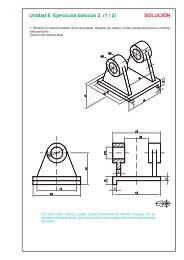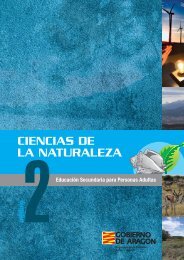Educación Secundaria para Personas Adultas 2módulo - aulAragon
Educación Secundaria para Personas Adultas 2módulo - aulAragon
Educación Secundaria para Personas Adultas 2módulo - aulAragon
You also want an ePaper? Increase the reach of your titles
YUMPU automatically turns print PDFs into web optimized ePapers that Google loves.
INGLÉS<br />
• Se colocan normalmente al final de la frase:<br />
We play tennis on Sundays<br />
We go to the swimming pool twice a wee<br />
THE PRESENT CONTINUOUS - PRESENTE CONTINUO:<br />
• Formamos el Presente Continuo con el verbo TO BE + V-ing<br />
Afirmativa Negativa Interrogativa<br />
I am working estoy trabajando I am not working no estoy trabajando Am I working?<br />
You are working estás ... You aren't working no estás ... Are you working?<br />
He/She/It is working está ... He/She/It isn't working no está ... Is he/she/it working?<br />
We are working estamos ... We aren't working no estamos ... Are we working?<br />
You are working estáis ... You aren't working no estáis ... Are you working?<br />
They are working están ... They aren't working no están ... Are they working?<br />
• (la forma interrogativa se traduce igual que la afirmativa con ingerrogación al final)<br />
• IMPORTANTE: usamos la forma completa del verbo TO BE en respuestas cortas:<br />
Is your brother learning Chinese? Yes, he is (NO Yes, he's)<br />
Are they eating a pizza? Yes, they are (NO Yes, they're)<br />
• Para respuestas negativas usamos la forma corta: Are they married? No, they aren't<br />
• ORTOGRAFÍA: VERBO + -ING<br />
Regla general: Los verbos que acaban en -e: Para verbos monosílabos con una<br />
vocal corta y una consonante final:<br />
Añadimos -ing al infinitivo: Omitimos -e y añadimos -ing: Doblamos la consonate y añadimos<br />
look - looking write - writing -ing:<br />
run - running<br />
Presente Continuo: USO Usamos este tiempo <strong>para</strong><br />
• Referirse a acciones que están sucediendo en el momento en que se habla.<br />
We are watching TV at the moment<br />
Estamos viendo la tele en este momento<br />
Where is your sister? She is having a shower ¿Dónde está tu hermana? Está duchándose<br />
• Para describir un estado temporal o de un periodo de un tiempo limitado<br />
My son is studying at university Mi hijo está estudiando / estudia en la universidad<br />
This year I am learning Chinese<br />
Este año estoy aprendiendo chino<br />
• Expresiones de tiempo<br />
Para describir una acción que ocurre en el momento en que se habla, usamos:<br />
– now (ahora)<br />
– right now (ahora mismo)<br />
– at the/this moment (en este momento)<br />
It's raining now<br />
Está lloviendo<br />
• Para hablar de acciones que ocurren en un periodo de tiempo más amplio, usamos:<br />
– this morning / afternoon / evening (esta mañana, esta tarde)<br />
– today (hoy)<br />
– this month (este mes)<br />
– this year (este año)<br />
This year I am learning Chinese<br />
Este año estoy aprendiendo chino.<br />
[ 42 ] Módulo 2


